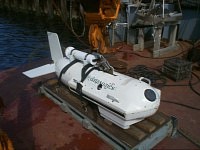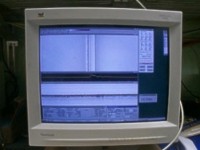U.S. GEOLOGICAL SURVEY
WOODS HOLE FIELD CENTER (WHFC)
|
Specifications for the Sidescan-Sonar
portion of the SIS-1000:
(for more information, see Benthos, Inc.) Sidescan Transducers: Multi-element array; single array transmit, dual array receivers -- 0.5-degree horizontal beam; 60-degree vertical beam |
--Windows 95 based Pentium machine |
Sidescan-Sonar files collected using the ISIS(TM)
system have the following format (Q-MIPS):
1st rec ---- ---- ---- *** Data is stored in
| ---- ---- ---- *** 1024 byte records for
| . each channel
| . (*** 256 byte trailer.)
| .
| .
V .
End rec ---- ---- ---- ***
Chan Chan2 ChanX (*** = 256 byte trailer.)
Each data file contains a 2048 byte file header followed by the sidescan-sonar data stream which consists of at least two channels of sidescan-sonar information and a 256 byte trailer. The trailer contains parameters relevant to the collected sidescan-sonar, such as altitude, file name, pitch, roll, date of collection, time of day, etc. The isis header and Isis sonar formats for the ISIS are described on the Q-MIPS page. |

